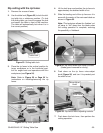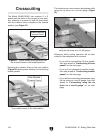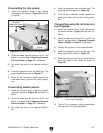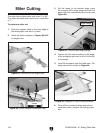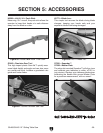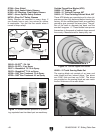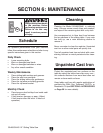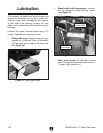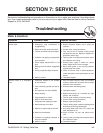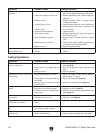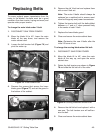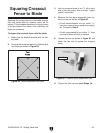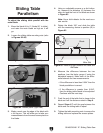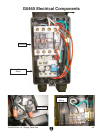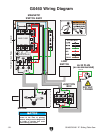
G0460/G0461 12" Sliding Table Saw
-43-
Review the troubleshooting and procedures in this section to fix or adjust your machine if a problem devel-
ops. If you need replacement parts or you are unsure of your repair skills, then feel free to call our Technical
Support at (570) 546-9663.
SECTION 7: SERVICE
Troubleshooting
Motor & Electrical
Symptom Possible Cause Possible Solution
Machine does not start or a
breaker trips.
1. Start capacitor is at fault (G0460).
2. Emergency stop push-button is
engaged/faulty.
3. Motor connection wired incorrectly.
4. Thermal overload relay has tripped.
5. Contactor not getting energized/has
burnt contacts.
6. Power supply switched OFF or is at
fault.
7. Blade guard limit switch engaged/at
fault.
8. Wiring is open/has high resistance.
9. Motor is at fault.
1. Test/replace if faulty.
2. Rotate clockwise slightly until it pops out/
replace it.
3. Correct motor wiring connections.
4. Turn cut-out dial to increase working amps
and push the reset pin. Replace if tripped mul
-
tiple times (weak relay).
5. Test for power on all legs and contactor opera
-
tion. Replace unit if faulty.
6. Ensure power supply is switch on; ensure
power supply has the correct voltage.
7. Move blade guard to the working position;
replace faulty limit switch.
8. Check for broken wires or disconnected/cor
-
roded connections, and repair/replace as nec
-
essary.
9. Test/repair/replace.
Machine stalls or is underpow
-
ered.
1. Workpiece material is not suitable
for this machine.
2. Feed rate/cutting speed too fast for
task.
3. Run capacitor is at fault (G0460).
4. Belt(s) slipping.
5. Plug/receptacle is at fault.
6. Motor is wired incorrectly.
7. Pulley/sprocket slipping on shaft.
8. Motor bearings are at fault.
9. Machine is undersized for the task.
10. Motor has overheated.
11. Contactor not getting energized or
has poor contacts.
12. Motor is at fault.
1. Only cut wood products; make sure moisture
content is below 20% and there are no foreign
materials in the workpiece.
2. Decrease feed rate/cutting speed.
3. Test/repair/replace.
4. Replace bad belt(s) as a matched set, align
pulleys, and re-tension.
5. Test for good contacts; correct the wiring.
6. Correct motor wiring connections.
7. Replace loose pulley/shaft.
8. Test by rotating shaft; rotational grinding/loose
shaft requires bearing replacement.
9. Use sharp blade with lower TPI; reduce the
feed rate/depth of cut.
10. Clean off motor, let cool, and reduce work
-
load.
11. Test for power on all legs and contactor opera
-
tion. Replace if faulty.
12. Test/repair/replace.



